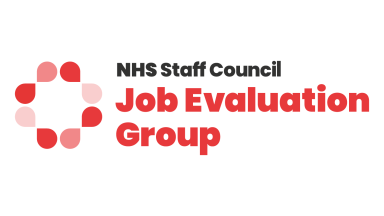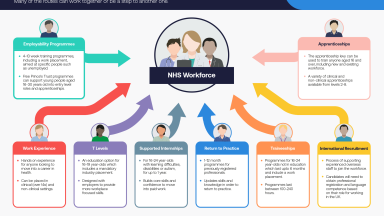Background
This toolkit contains advice, tools and resources to support health and social care organisations to recruit people who have experienced homelessness into the workforce, to support them to stay in their roles and become an asset to the organisation.
It has been developed with people who have experienced homelessness, and NHS trusts that have employed people who have experienced homelessness. With a focus on supporting individuals with lived experience of homelessness to enter and thrive in their roles, this resource can be used by any organisation looking to create a more diverse and inclusive workforce. From recruitment tips and strategy to retention practices, you'll find what you need to start to incorporate this important aspect of inclusion into your employment practices.
By taking steps to recruit and support individuals who have experienced homelessness, your organisation can make a positive impact on both the lives of these individuals and the communities you work with.
The toolkit is aimed at employers and managers with responsibility for recruitment and retention strategy and activity for entry-level roles such as healthcare support workers, cleaning, administration, porters, maintenance and others.
It has been commissioned by NHS England, working with input from Pathway, the Royal Society for Public Health, Groundswell and NHS organisations.
How to use this toolkit
Use the +chapters navigation menu at the bottom of your window or click on a chapter on the right-hand side of the page to explore the different stages of the recruitment journey and how they can be adapted for people who have experienced homelessness.
Within each section of the toolkit there are key points to consider and top tips to support progress through every stage of the recruitment process, including checking your organisation’s readiness to proceed with this initiative. The toolkit can also help you to evaluate the level of support within your organisation and identify any areas that may require further attention or discussion.
What do we mean by lived experience of homelessness?
Homelessness takes on various forms, ranging from rough sleeping (being outside on the street) to temporary and/or insecure accommodation, sofa surfing, domestic abuse refuges, or even non-fixed locations like traveller sites. When we talk about the lived experience of homelessness, we encompass all these different situations. People who have encountered homelessness often face systemic barriers in areas such as employment, as well as increased health inequalities. Those with lived experience of homelessness are often experts by virtue of their own experiences, possessing valuable skills in developing and engaging with solutions to homelessness.
Homelessness is not merely a statistic or a remote issue that affects others, it is a reality that can touch anyone at any stage of their life. By understanding the diverse forms of homelessness and acknowledging the expertise of those who have lived through it, we can foster a more engaging and inclusive dialogue.
Homelessness is an experience, not an identity and during the development of the toolkit we have involved people who have experienced homelessness. It is important to avoid using terms like 'the homeless', however you can use 'people who are homeless' or 'people who have been homeless'. Throughout the toolkit we use the term 'people who have experienced homelessness', sometimes abbreviated to PEH.
Getting started
Find a partner organisation
To successfully recruit individuals with experience of homelessness, it is important to have good community links and support structures in place. It can be beneficial to partner with a local voluntary, community, and social enterprise (VCSE) organisation with experience in supporting individuals experiencing homelessness.
Partner organisations can help with identifying potential candidates and provide support to help them engage with organisations ahead of any pre-training and recruitment. They may also have links with other local VCSE organisations and the Department for Work and Pensions (DWP) to help identify individuals who would make great candidates and to support them in their journey towards employment.
Having funding available to support this work can be beneficial, and this could potentially be found in existing recruitment budgets or by applying for funding via an integrated care system (ICS) or grants organisation.
The initial support provided by a partner organisation can be invaluable in helping individuals to engage, and to address any issues related to moving into work from benefits or the type of accommodation they may be living in. It is crucial to work closely with partner organisations to ensure individuals have the necessary resources and support to assist with the recruitment process.
Top tips
-
Good community links and support structures are vital both to finding people who have experienced homelessness and enabling them to participate.
-
Build a partnership with a local VCSE organisation that has links to supporting people with homelessness issues and helping people into employment.
-
Partner organisations can work with other local VCSE organisations and the DWP to find applicants, helping them to engage with the trust ahead of any pre-training and recruitment.
-
Funding is needed to support the work. Possible routes include from funds already allocated to recruitment, or making a bid for funding via an ICS or grants organisation.
Have you got organisational buy in?
It is important to have buy in and agreement from all relevant stakeholders in the organisation to move forward with the targeted recruitment of people who have experienced homelessness. This includes senior/executive leadership team members responsible for workforce development; recruitment teams who are willing and able to amend processes; line managers who will support people recruited; and any other staff responsible for the wellbeing and development of colleagues.
If all these stakeholders within the organisation are on board, you are ready to move forward.
Things to consider
It is important to have buy in and agreement from all relevant stakeholders in the organisation before moving forward with the targeted recruitment of people who have experienced homelessness. This includes:
- senior/executive leadership team members responsible for workforce development
- recruitment teams who are willing and able to amend processes, for example changing application routes
- line managers who will support people who are recruited
- any other staff area that is responsible for the wellbeing and development of colleagues.
Where are your vacancies?
When identifying roles to recruit people who have experienced homelessness, it's important to consider the organisational structure in which these roles will sit. It may be helpful to ensure that there are established colleagues who can offer to buddy up with the new recruits.
It's also important to ensure that the roles are easily accessible by public transport, since many potential recruits may not have access to a car.
To avoid putting up unnecessary barriers, it's recommended not to ask for qualifications that are not essential for the role. Possible roles for recruitment could be healthcare support workers, porters or administrative positions. It's good practice to share and discuss the suitability of roles and finding participants for the programme, with the partner organisation that is supporting the recruitment exercise.
Top tips
-
Consider where in the organisation the roles will sit when your trust is considering recruiting people who have experienced homelessness.
-
There should be scope for recruits to have buddy support from an established colleague(s).
-
Consider if the role is easily accessible by public transport.
-
It is good practice to share and explore suitability of roles with the partner organisation that is supporting the exercise.
-
Don’t ask for unnecessary qualifications.
Moving things forward
Recruitment and selection
Accessible application process
Creating an accessible application process is vital to ensure individuals from diverse backgrounds, including those who have experienced homelessness, can successfully apply for roles.
Adapting the application process will create a more inclusive and accommodating environment for applicants. For example, by allowing CV-based applications with tailored supporting statements, alongside other guidance and support.
Here are some ways the application process can be made more accessible:

Rethink the online platform: The current recruitment process relies predominantly on the NHS Jobs online platform. However, this platform is designed for a standardised application process and lacks the flexibility to accommodate individuals coming from diverse pathways. Consider allowing applicants to apply via a CV, allowing for any employment gaps, alongside a supporting statement. This approach provides an opportunity to get to know the applicant, valuing personal experiences that may not have been acquired in a workplace.

Tailor supporting statement questions: Provide applicants with specific questions to answer in their supporting statement. Tailoring the questions allows candidates to showcase their skills, experiences and suitability for the role in a way that reflects their unique backgrounds. By focusing on individual strengths and experiences, you create a more inclusive and accessible application process.

Provide guidance and support: Incorporate guidance and support for the application process into any pre-employment training. Participants can benefit from understanding how to effectively complete a CV and write a compelling supporting statement. Include guidance on highlighting transferable skills, addressing any gaps in employment history, and tailoring their application to meet the specific requirements of the role. This support ensures that applicants feel confident and empowered during the application process.
Pre-application/employment training
When partnering with local organisations and individuals to identify potential candidates for employment in your organisation, running a pre-application or pre-employment training course can be highly valuable. Such a course helps individuals with limited employment history or significant time away from work, to build their confidence and gain insights into suitable roles within the trust. Here's an overview of things to think about when planning this training:

Selecting a suitable venue: Take care in choosing an appropriate venue for the training. Local community centres can often provide a welcoming and inclusive environment. Alternatively, if your organisation has training rooms or facilities, conducting the training on site may be an option. It's essential to select a venue that feels accessible and not intimidating to individuals who may have had negative experiences in more formal settings. For example, it may be worth avoiding conference centres or hotels.

Embedding a qualification: To enhance the value of the training, consider incorporating a qualification into the programme. For instance, the Royal Society for Public Health (RSPH) offers a range of accessible qualifications which may be suitable. Including relevant qualifications alongside other training components not only boosts participants' confidence but also provides tangible evidence of their skills during interviews and in future roles.

Creating a supportive environment: By offering pre-application or pre-employment training, you create a supportive environment where individuals can develop their skills, gain confidence and explore potential roles within your organisation. This alongside thoughtful selection of the training venue and by incorporating qualifications will contribute to a positive and empowering experience for participants.
Top tips
-
Consider running a pre-employment training course. This can help to build confidence in people who have had time away from employment or a limited employment history, combined with the history of experiencing homelessness, and learn about roles that may be suitable for them.
-
Consider a suitable venue for the training. Local community centres may be good for this, or training rooms or other suitable facilities on the organisation's premises.
-
Consider embedding a qualification within the training. For example, the RSPH has a range of accessible qualifications that may be suitable, such as the Level 1 Award in Health Improvement.
Design and delivery of pre-application/employment training
Design
When designing training for individuals who have experienced homelessness and are seeking employment, it's essential to adopt an asset-based approach that recognises and validates their life experiences, skills and knowledge. Participants often don't realise the transferability of these skills. They may assume that experiences outside the traditional workplace are irrelevant to employment, or some experiences may be associated with trauma, making it difficult to extract positive aspects.
Therefore, any training should have a significant focus on sensitively exploring and validating past experiences. The final step in this process involves mapping these skills and experiences to the specific job requirements. This helps individuals build trust and belief in the transferability of their assets to the workplace, boosting their confidence in pursuing opportunities.
Some organisations may opt for pre-employment training before the application process, while others may provide some training after acceptance but before starting the role.
Delivery
There are various approaches to delivering this training, including bringing in a trainer from organisations like RSPH or conducting in-house training. Even with in-house delivery, support can be sought from RSPH or partner organisations.
A crucial aspect of training delivery is the use of scenario-based learning. Participants should be exposed to scenarios that offer insights into the demands of the role they are applying for. Many participants may have spent a significant amount of time outside of employment. Using scenarios, such as asking participants to describe a typical day in the role they're applying for, helps gauge any knowledge gaps related to day-to-day working life.
Scenario-based learning also addresses apprehension about the role's day-to-day responsibilities. It allows participants to apply their identified skills and knowledge in practical situations, reinforcing their belief in their ability to perform the job.
Additionally, training should not make assumptions about participants' perceptions. It should not assume automatic interest in the job, and acknowledge potential barriers that participants might associate with working for the NHS. Some individuals might have had negative experiences as patients, leading to doubts about whether the NHS would accept them.
Training materials should be carefully chosen to match the needs of participants. Qualifications like the RSPH Level 1 Award in Health Improvement can be beneficial, but might inadvertently serve as a barrier to those with negative educational experiences. The choice of qualification should consider its relevance to the role, the assessment method (such as a workbook rather than an exam), and accessibility to all participants.
Finally, the training should equip participants with tools to use in employment. This may involve introducing them to NHS workplace initiatives such as Making Every Contact Count and the Care Certificate, and providing insight into the skills and knowledge needed to implement them. This not only boosts their confidence during interviews but also prepares them to meet key job requirements once employed.
Things to consider
-
The obvious transferability of skills and knowledge to the role, making the qualification relevant to those taking part.
-
The use of a workbook assessment instead of any kind of examination, which can be off-putting to individuals who have spent a significant amount of time outside of education and employment.
-
The need to ensure that the level of training was accessible to all individuals taking part in the programme.
-
The importance of developing tools to use when in employment:
- It can be good to give participants exposure to a number of NHS workplace initiatives, such as Making Every Contact Count and the Care Certificate, as well as insight into the skills and knowledge that are needed to deliver them.
- This can be useful in building participants’ confidence in their ability to successfully apply for the job in question, by being able to reference the standards at interview. It can also build confidence to carry the job out once in post, as they feel like they have a head-start in understanding and being able to meet some of the key requirements that would be expected of them.
The interview process
Unlocking success in job interviews
Candidates who have experienced homelessness may not have attended interviews for a long time and may have had poor experiences previously. The goal is to create a space where applicants can demonstrate their abilities, irrespective of whether those experiences stem from professional roles or life experiences.
Guiding inclusive job interviews
Setting the stage:
- A welcoming atmosphere
Begin by fostering an atmosphere of acceptance and warmth. Remember that applicants may be apprehensive, and a friendly demeanour goes a long way in easing nerves. - Inclusive interview questions
When formulating interview questions, make sure that they invite responses from various areas of an applicant's life, not solely from work experience. Inclusivity is the key, encouraging candidates to draw from their unique journey.
Crafting inclusive questions:
- Scenario-based questions
Create questions that revolve around real-life scenarios. For instance, enquire about a challenging situation they've navigated, regardless of its origin. It could be a work-related issue or a personal hurdle. - Transferable skills
Ask candidates to reflect on skills they've acquired and invite them to share how these skills are relevant to the role. This approach allows for a broader interpretation of their abilities. - Problem-solving scenarios
Present scenarios that require creative problem-solving. Encourage candidates to propose solutions based on their personal or work and volunteering experiences.
Inclusive interview questions give candidates an opportunity to showcase their adaptability, resilience and problem-solving abilities regardless of whether their experiences originate in work settings or life's diverse journey. By creating an environment where all aspects of an applicant's journey are valued, we ensure that individuals who have experienced homelessness have a fair chance to shine and contribute to the NHS workforce.
Tips for inclusive interviews
-
Scenario diversity: incorporate a mix of scenarios that encompass workplace, volunteering, and personal experiences. This showcases the candidate's adaptability and problem-solving abilities in various settings.
-
Transferable skills: ask questions that focus on skills rather than specific job roles. For instance, inquire about their teamwork, communication or resilience skills and request examples from any area of their life.
-
Problem solving: present problems that candidates can address from their unique life perspectives. By making these scenarios relatable to personal experiences, applicants can demonstrate their ability to tackle challenges.
-
Empathetic approach: maintain a compassionate and empathetic stance throughout the interview. Encourage candidates to share openly and acknowledge the strength in their stories.
-
Thorough listening: actively listen to the responses, even when they draw from non-work experiences. Look for key skills and qualities that align with the role's requirements.
Staying connected
To ensure a smooth and engaging recruitment process, it is important to maintain good communication with recruits throughout the pre-employment checks. This process can often take some time, so regular check-ins with a key contact, agreed upon by both the trust and the recruit, is best practice, with at least a fortnightly frequency.
Many individuals who have experienced homelessness may not have been employed for a long time, so providing support and guidance to help them complete necessary forms or processes is crucial. It's important to take time to understand any potential barriers and help where needed, whether that is online or offline support.
Continuing to work with the VCSE organisation that has links to supporting those who have experienced homelessness, or working with the DWP, can provide additional support and advice on any potential needs. Maintaining communication and links with these organisations can help ensure successful outcomes.
Top tips
-
Keep the time taken to complete pre-employment checks to a minimum, and maintain two-way communication throughout to keep the recruits engaged.
-
Have one key contact for the recruits and agree a regular check in at a frequency agreed by both the trust and the recruit (recommend at least fortnightly).
-
Take time to explore what support recruits may need to complete the pre-employment checks or associated forms either online or offline.
-
Maintain regular communication with the partner organisation supporting VCSE links or working with the Department for Work and Pensions. They may also be able to advise or assist on how to best support recruits during this phase.
Understanding Disclosure and Barring Service checks
As with most patient-facing roles in the NHS, it is likely that you will conduct Disclosure and Barring Service (DBS) checks on people you recruit as part of your pre-employment checks. It's important to remember that people who have experienced homelessness may also have experience of the criminal justice system and may have obtained a criminal record during this time. Disclosures around this may be a challenge for the recruit, and it's important to approach the discussion with sensitivity and understanding.
When someone has experienced homelessness, particularly if it was long term, it can be hard to recall exact dates of any offenses and their history. It's important to take this into consideration when exploring any disclosures and try to acquire additional context.
Alongside the other pre-employment checks, it's important to have one nominated contact to maintain communication with any recruit. This person can provide support and guidance throughout the recruitment process, including discussing any disclosures and ensuring that the recruit has access to the necessary support.
NHS Employers provides further guidance on positive disclosure discussions.
This will help to ensure fair and inclusive recruitment while upholding standards for patient and colleague safety.
Remember that, for a range of reasons, disclosures may be a challenge for the recruit.
We advise that you have one nominated contact to maintain communication with the recruits during this phase of the process.
Facilitating job offers
The process of offering a job is a pivotal moment in the journey towards inclusive employment. This section encompasses not only extending an offer to candidates, but also understanding the unique needs of those who have experienced homelessness.
Extending job offers:
- Clear communication: when extending a job offer, communicate clearly and empathetically. Recognise that this may be a new experience for many participants and offer support in gathering the required documentation.
- Documentation guidance: provide guidance on the documentation needed for employment, such as proof of identity and eligibility to work. Some applicants may require assistance in understanding and obtaining these documents.
- Flexible timelines: be flexible with timelines for document submission, considering that candidates may need additional time or support to gather necessary paperwork.
Support for unsuccessful candidates:
- Constructive feedback: for unsuccessful candidates, offer constructive feedback to help them understand areas for improvement. This feedback can empower them to continue their job search more effectively.
- Alternative opportunities: explore the possibility of offering volunteering opportunities within the NHS or signposting them to relevant support agencies. This helps candidates remain engaged with the prospect of future employment.
- Mentoring and development: consider offering mentoring or development opportunities to unsuccessful candidates. This support can help them build their skills and confidence for future job applications.
Nurturing inclusivity:
- Promote inclusivity: emphasise the importance of an inclusive work environment, where diverse experiences are valued and contribute to a richer workplace culture.
- Encourage participation: encourage candidates to actively engage in NHS networks and support groups, even if they are not immediately successful in securing a job. These platforms can provide valuable connections and support.
- Recognition of effort: acknowledge the effort and determination shown by all candidates, regardless of the outcome, in taking the steps towards securing meaningful employment.
In the process of extending job offers and supporting candidates who have experienced homelessness, remain sensitive to their lived experiences. By offering clear communication, guidance and constructive feedback, they can be supported in this journey, whether it leads to immediate employment or opens doors to future opportunities within the NHS.
Supporting and retaining new recruits
Induction
When it comes to the induction process for recruits who have experienced homelessness, it's important to treat it as starting immediately after a job offer has been made. Even though there will be pre-employment checks to complete, it's crucial to maintain communication and preparation to build trust and confidence.
To help new recruits settle in, arrange a plan for them to meet their line manager and colleagues. It's also a good idea to introduce them to a buddy: an experienced and supportive colleague who can assist and mentor them during their early days.
Clear, two-way communication is essential during this process, so make sure to provide any induction or training plans for the role and check that the recruit understands them and feels comfortable with them. It's important to bear in mind that for many people who have experienced homelessness, this may be their first job or their first job in a long time, so they may feel daunted by the experience.
Remember that it is up to the individual whether they choose to share their personal history of homelessness with their team.
We highly recommend setting up a wellness action plan with guidance from Mind, which can support individuals to identify any challenges they may face in their work and plan for managing them effectively.
Top tips
-
Treat the induction process as if it starts immediately after the job offer.
-
Put in place a plan for the recruit to meet their line manager and colleagues.
-
Introduce a buddy.
-
Make sure communication is two way and clear.
-
Remember the prospect of starting or restarting employment may be daunting to individuals.
-
Do not put any pressure on the individual about whether or not to share their personal history of homelessness with their team.
-
Highly recommend setting up a wellness action plan with guidance from Mind.
Individual support needs
It's important to consider individual support needs when recruiting individuals who have experienced homelessness into the NHS. One way to do this is by offering advice and support around the impact on finances and welfare benefits of moving into employment. It's recommended to develop an individual plan for each person and work with the partner VCSE organisation you have engaged to help facilitate this, or support with accessing help from the DWP. If your trust has workers who support people into employment, it would be good to engage them.
Another way to support individuals is by discussing transport options and locations, and ensuring they have a plan in place. It's also important to be clear on work schedule and shift patterns, as well as locations for work, including anywhere used for training. Emphasise the importance of communication between the recruit and the trust and encourage addressing any issues or concerns early for everyone's benefit.
Top tips
-
An individual plan for each person should be offered and it would be helpful to work with the partner VCSE organisation to help facilitate this, or engage with the DWP.
-
Include advice and support around the impact of moving into employment on finances and welfare benefits.
-
Discuss transport options and locations and help to ensure people have a plan in place.
-
Be clear on work schedule and shift patterns, and the expectations around this for both the trust and the recruit.
-
Have clarity on locations for work including anywhere used for training.
-
Emphasise the importance of communication between the recruit and the trust both ways, addressing issues and concerns at early stages.
Ongoing support
Irrespective of whether or not a recruit has entered through the pathway for individuals with experience of homelessness, providing ongoing support, development and progression opportunities is crucial for their engagement and staff retention. Here are some key considerations to foster a supportive and inclusive environment and ongoing support:

Emphasise ongoing support and development: Acknowledge that individuals who have experienced homelessness may have missed out on opportunities throughout their lives. Your trust may have, or have access to, an education department or links with local colleges. Encourage recruits to access resources, such as English/maths support or other development opportunities, to enhance their skills and confidence.

Foster clear communication pathways: Maintain clear communication pathways and expectations to cultivate a positive work environment. Encourage open dialogue between staff and managers, providing channels for raising issues, providing feedback and addressing concerns. Creating a culture of open communication promotes an environment where everyone's voice is heard and valued.

Encourage participation in equality, diversity, and inclusion groups: If your trust has equality, diversity, and inclusion (EDI) groups, such as LGBTQ+, BME, and disabled and neurodivergent staff networks, actively encourage membership. These groups can provide valuable opportunities to forge connections, build friendships, and access peer support. Encouraging participation in EDI groups promotes a sense of belonging and fosters an inclusive workplace culture.

Explore internal career pathways and development plans: Look into internal career pathways, apprenticeships and development plans as avenues for future progression. Encourage individuals to explore opportunities for career growth within the trust. By providing clear pathways and development plans, you demonstrate your commitment to supporting their long-term professional aspirations.

Creating a supportive and inclusive environment: this benefits not only individuals with experience of homelessness but the entire workforce. By prioritising ongoing support, fostering open communication, promoting EDI group participation, and offering career development opportunities, it will help ensure a positive and inclusive environment for people with lived experience of homelessness, and the wider team will also see the benefits.
Top tips
-
Utilise your organisation's education department or local college links where recruits can access English/maths support or other opportunities.
-
Maintain regular communication pathways on both sides to raise issues and share feedback.
-
Membership of staff networks should be encouraged as they can be great areas to make friends and access peer support.
-
Internal career pathways, apprenticeships and development plans are a great way to plan future progression.
Settling in
When new starters begin their role, it's important to have regular check ins with them to ensure any issues are addressed early on. Communication about the support available to them should be clear, including escalation routes for any concerns. It's also worth considering additional training and support, such as training in areas like maths and English. Every new starter should have an established colleague acting as a buddy to support them as they settle in.
Be on the lookout for warning signs that a new starter may be struggling, such as feeling stressed or confused, or appearing disengaged. Don't be afraid to raise these concerns in a supportive manner and see what can be done to help. Keep in mind that settling in may not be a linear process, especially if it's someone's first job or their first role in a while. Building in flexibility and setting SMART objectives can help support new starters during this transition.
Top tips
-
Have regular check ins with new starters to make sure any issues are highlighted and addressed early.
-
Ensure clear communication about support available and escalation routes.
-
Consider additional training and support.
-
All new starters should have an established colleague acting as a buddy.
-
Look out for warning signs of stress, such as confusion or if the recruit appears disengaged.
-
Recognise that starting a new role may not be linear and build in flexibility to accommodate this.
Useful links
You can find the original study, which explored employing people who have experienced homelessness in the NHS, via the King's College London website.
You can also sign up your organisation to the Crisis Homelessness Covenant.
Related resources
Contact
NHS Employers widening participation team - wideningparticipation@nhsemployers.org
NHS Employers workforce supply - workforcesupply@nhsemployers.org











